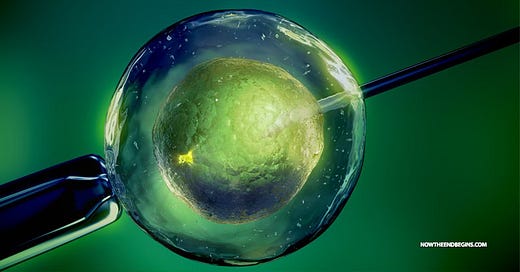In Vitro Gametogenesis
Artificial gametes, a technology on the horizon, portend a radical restructuring of familial ties and human lineage.
While it has not yet been perfected in humans, we now have the capability in other mammals to produce gametes—either eggs or sperm—from adult stem cells such as skin cells using techniques of genetic manipulation. The procedure, known as in vitro gametogenesis (IVG), involves programming stem cells to differentiate into gametes—sperm or eggs. In 2018 the first human egg cells (though not viable eggs usable for IVF) were created in a lab using this method. In 2024, researchers at Oregon Health Science University (OHSU) developed a more efficient technique do to this in mice that avoids problematic genetic alterations.[1] Many researchers are working on applying these IVG techniques to humans.
This procedure would allow many who are unable to have genetically related children to do so, including for example, women of advanced maternal age or women unable to produce viable eggs due to cancer treatment or other medical issues. Such promises make it attractive to many prospective parents. More radically, however, because it may be possible to produce eggs from male cells or sperm from female cells, IVG would allow men (or women) in same-sex relationships to have children who are genetically related to both dads (or both moms), one supplying an artificial egg, the other the sperm. This would deny children the right to have both a genetic father and mother and radically alter our deeply held notions of human lineage, motherhood, and fatherhood.
As explained in the previous section on embryonic genetic testing, a typical IVF egg-harvesting cycle can produce at best only about half a dozen eggs, thus limiting the number of embryos that can be created and destroyed in a laboratory. However, because the IVG technique uses skin or other easily obtainable cells, rather than an invasive procedure, it would permit an inexhaustible supply of eggs, and thus, the potential to easily create hundreds of embryos in the lab. This would amplify the potential for commercial eugenics on a massive scale via “embryo farming,” where hundreds of embryos are tested and only the genetically “strong” or “select” few allowed to survive.
IVG would likewise permit other frankly bizarre scenarios, such as the unauthorized use of someone’s genetic material to produce offspring that are genetically related to a person who did not consent to have children. The hotel maid who wants to have Brad Pitt’s children could merely scrape some skin cells from his pillow and pay a firm to turn these into sperm using IVG, then use that sperm in an IVF procedure.
The deployment of IVG portends a radial refashioning of family structures, altering the relationship between the generations in ways that we can barely comprehend. Some IVG enthusiasts, for example, celebrate the potential for “multiplex parenting.[2] Suppose four individuals wanted to have a child genetically related to all four of them. They could pair up and use IVF to create two embryos in the lab—one related to one pair and the other to another pair in the foursome. Then embryonic stem cells could be extracted from each of those embryos, and through IVG, another set of sperm and eggs could be created from those embryos. Those two embryos could be discarded and the gametes derived from them would then be used to create a third embryo, which would then be brought to birth.
All four members of the group would be genetically related to the child; technically, they would be genetic grandparents, not parents. The genetic parents would actually be two embryos that were created and destroyed in the lab. In fact, this cycle of embryonic stem cells to gametes to embryos to embryonic stem cells, and so forth, could be theoretically repeated as many times as one wanted in a lab—ultimately producing a child with no living genetic relatives—a child whose parents, grandparents, great grandparents, etc., were all embryos created and destroyed in a lab. The generations would be “compressed” in space and time, and the resultant living human being would be without a meaningful family history or genetic lineage of people who had actually lived full human lives.
Those who are ready to embrace this brave new world of human reproduction seem incapable of thinking deeply about the seriously harmful effects on children, on the relationship between generations, on family structure, and an individual’s genetic identity. If such a dystopian scenario becomes our future reality, we will have turned procreation into a manufacturing process, instrumentalizing human life and discarding—on a massive scale—human lives deemed unfit to exist.
These “Wild West” domains of human reproduction are subject to virtually no regulation at the federal or state level and have been subjected to almost no public discussion or democratic debate. Thoughtful regulatory action is now necessary, since these techniques are already available (PGD) or will soon be available (IVG) for use on human beings.
[1] Mikhalchenko A, et al. “Induction of somatic cell haploidy by premature cell division.” Science. Adv.10, eadk9001 (2024). DOI:10.1126/sciadv.adk9001
[2] C. Palacios-Gonzalez, J. Harris, and G. Testa, "Multiplex Parenting: Ivg and the Generations to Come," J Med Ethics 40, no. 11 (2014).





The hubris is beyond my comprehension
This is truly frightening and, also, very dangerous. I can see some attempting to produce a superhuman. Please, let’s let God determine the future of the human race.